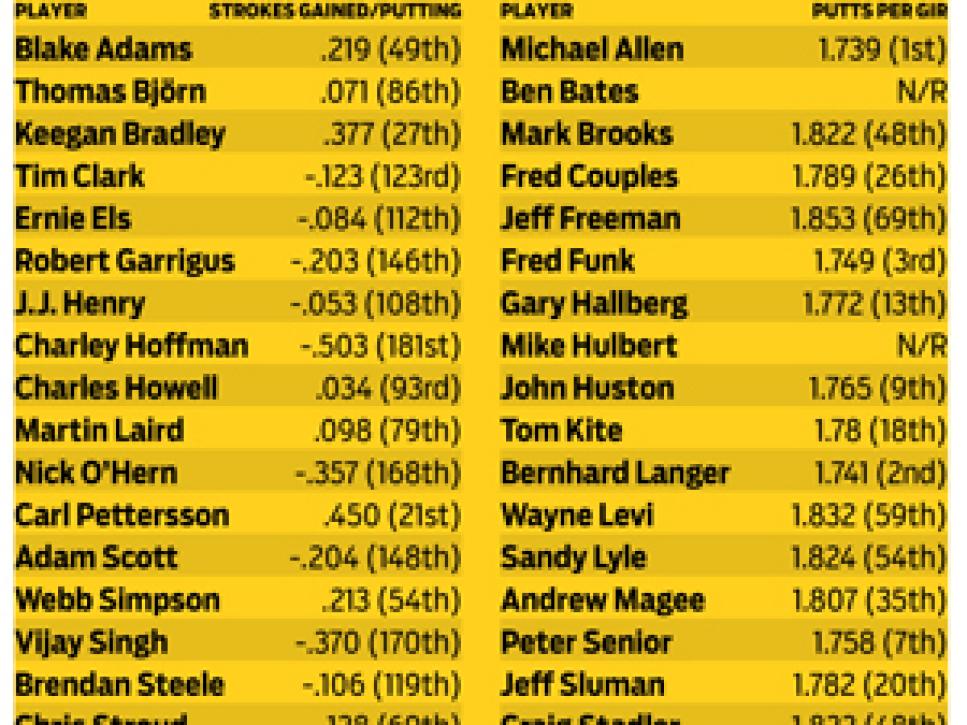News
Coming to Grips With Anchoring

Bradley had reason to try and stare down the governing bodies over the anchoring ban but chose a more conciliatory tone.
A day after Ernie Els dropped a 15-foot putt on the 72nd hole of the British Open at Royal Lytham & St. Annes in July, giving belly putters wins in three of the last four majors, the R&A conducted its annual post-Open press conference, where the topic of anchored putters was quickly brought up.
"We appreciate that there is much speculation about this and that we need to clarify the position as soon as possible," said Peter Dawson, chief executive of the R&A. "I think you're going to see us saying something about it one way or the other in a few months, rather than years."
On Nov. 28, Dawson and USGA executive director Mike Davis jointly announced a proposed rule that would prohibit the anchored style of putting. Rather than ban belly or long putters, it would ban any stroke where the grip or hand is anchored "directly" or by use of an "anchor point" on the body.
The ruling bodies are seeking comment from golfers and the golf industry over the next three months before making a final decision. Assuming the timeline remains unchanged, the rule will be approved by both the USGA and the R&A in the spring, and the anchored-stroke ban would go into effect with the next official revision of the rules in January 2016.
"It's been a polarizing issue, and for many years you've had people who genuinely care about the game sit on both sides of it," said Davis. "It's been fairly divisive, and it's only gotten more so in the last year."
Although overlength putters have been around the game in a small way since the 1930s, long and belly putters have been used in 15 victories in the last two years on the PGA Tour, including the 2011 PGA Championship (Keegan Bradley), the 2012 U.S. Open (Webb Simpson) and the 2012 British Open (Els). Davis also pointed to data that suggested belly and long putters were used by 3 to 4 percent of tour players from the 1980s through the mid-2000s before a sudden jump to 11 percent in 2011 and 15 percent this year.

Once an opponent of anchoring, Els' career received a kickstart from the belly putter, including his fourth major at this year's British Open. Photo: J.D. Cuban
"We're nervous about where this could lead, not just in putting. We're starting to see people do it with chip shots, and we just think fundamentally that is not golf," said Davis, noting it is not just a tour trend. According to the American Junior Golf Association (AJGA), approximately 2 percent of its roughly 5,000 members use long or belly putters. Tianlang Guan, 14, wielded a belly putter in winning the Asia-Pacific Amateur Championship and, with it, a spot in next year's Masters.
Judging from early reaction, the road from proposal to actual rule is likely to be littered with conversation and debate. Response to the possible ban on anchoring was swift -- as to be expected in this day of 24-hour news cycles and social media outlets where anyone with an opinion and a computer or cell phone can chime in instantly.

"I knew the wording of the rule was going to be key, and you know, it's a very considered and intelligent sort of decision," said Graeme McDowell at the World Challenge. "I think it was the only decision that could be made."
Brandt Snedeker went a step further, not only endorsing the proposed rule, but the USGA and R&A's authority as the game's rulesmakers as well. "I say this all the time, we as tour pros, we all think we're very, very smart," said Snedeker. "We're not when it comes to governing the game of golf. We have no clue how to do that. The USGA and the R&A do. Peter Dawson and Mike Davis are extremely intelligent people. They know what they're doing when it comes to the game of golf."
Those on the other side were equally passionate.
PGA of America president Ted Bishop cited his organization's online survey in which 63 percent of respondents were against a ban on anchoring. Bishop, making an appearance on Golf Channel, is concerned that a ban might affect the growth of the game and could possibly impact the enjoyment of those already playing.
"Let's face it, when people are playing better, they play more golf," said Bishop. "Fundamentally and philosophically to the PGA of America, it's disappointing that anything would happen in the sport of golf that would have any potential negative impact on enjoyment and number of rounds played."
Although the LPGA and European tours appeared to be on board, the PGA Tour was somewhat vague, stating, "While the USGA and the R&A have kept us updated on this proposed rule change, we only recently have been able to review the final language and have not until now had the opportunity to share it with our Policy Board and membership." The tour said the matter would be discussed at its next player meeting in San Diego in January. Among the possible items for discussion is whether the tour, given that its 2016 schedule actually starts in 2015, would opt for an earlier implementation of the rule if adopted.
Champions Tour member Tom Lehman was sharply critical of the proposed rule, saying, "There are many young players who have grown up with the belly putter, never even using traditional methods. To tell them it is illegal or against the spirit of the game is way late, very unfair and in my opinion unethical."

Photo: Dom Furore
Still, two of the poster boys for anchoring kept their angst in check -- at least for now.
"It's difficult for me to 100 percent understand this," said Bradley, whose win with a belly putter at the 2011 PGA Championship is often looked at as a tipping point in the anchoring discussion. "I understand the USGA is trying to protect the game. ... There's part of me that realizes there's not much I can do personally. I just want to make it obvious that I respect what the USGA is trying to do. I don't want to say the wrong thing."
Simpson also spoke stoically about the proposed ban. "It's something I expected," he said. "I knew they were going to do it, so it didn't surprise me. I've got 3½ years to adjust, hopefully I'll be in a short putter before that."
In 1989, the USGA made a statement saying that it thought long putters were OK for the game, and Davis said the association still stands by that statement. "This is all about the stroke," said Davis. "This decision gets back to the USGA and R&A feeling that fundamentally golf for 600 years has been about picking up the club, gripping it with two hands and making a free swing away from the body. ... In this case, the game has always been about swinging the club freely, and the anchored stroke is really a diversion from that."
The rule's proposed language is not overly complicated. Slated to appear under Rule 14, Striking the Ball, the new stipulation would be listed under Rule 14-1b, Anchoring the Club, and would read as follows:
*"In making a stroke, the player must not anchor the club, either 'directly' or by use of an 'anchor point.' *
Note 1: The club is anchored 'directly' when the player intentionally holds the club or a gripping hand in contact with any part of his body, except that the player may hold the club or a gripping hand against a hand or forearm.
Note 2: An 'anchor point' exists when the player intentionally holds a forearm in contact with any part of his body to establish a gripping hand as a stable point around which the other hand may swing the club."
[#image: /photos/55ada47fadd713143b43f829]|||anchor putting dos and donts|||View a slideshow of the USGA's official list of what is and what is not permitted in Rule 14-1b
The proposed rule doesn't restrict the use of any currently conforming equipment. "You can use that same club and just move the club, your hand or your forearm off the chest and putt that way," Davis said. "We're not trying to hurt the game, we're giving you options." Some unique putting styles aren't characterized as anchoring by the new rule. Examples of accepted strokes include bracing the grip against the inside of the forearm with the opposing hand (similar to Bernhard Langer's method in winning the 1993 Masters) or allowing the grip to extend up from the hands but rest against the lead forearm (similar to the stroke employed by Matt Kuchar). The USGA has produced a Power Point presentation, a poster and a video that illustrate which strokes are permitted and which aren't under the new proposal.
Still, there is no doubt that the ruling will put a chill on the sales of long and belly putters. In fact, since talk heated up on the topic this spring, sales of such clubs have tumbled.
Most equipment manufacturers, however, seem unconcerned about the proposal. "Does it mean the demand for these kinds of putters would drop? Maybe," said Mark King, president and CEO of TaylorMade. "But, at the end of the day, I don't think we would sell one more or one less putter if this change to the rules is made."
Retailers, however, indicate they might have difficulty moving inventory. "At their peak last spring 30 percent of our putter sales were either mid or long length," said Sven Kessler, VP of retail sales for Edwin Watts. "That number has dropped substantially since the rumor surfaced this summer [that anchoring might be banned], and we will have trouble selling existing long putters with customers knowing [that method] will not conform in a few years."
Davis acknowledges such difficulties but still believes the rule change is the right thing for the future of the game. "We understand the other side," he said of the possibility of pushback, even lawsuits. "We hate to think that it would get to that point, but we're going to do what we think is right for the game, and if we have to get involved in litigation, we will.

"If we don't do what we think is right just for fear of a lawsuit, then shame on us," Davis said. "We shouldn't be in the governance business then."
But Davis isn't adopting an aggressive stance. He knows there will be some initial difficulties, and he is sensitive to any negative reaction the proposal might receive.
"It's a hard issue short-term," he said. "We understand the other side, we don't want to hurt golfers, we don't want to hurt the game, but we just want to clarify what the game should be, and we feel this is the right thing to do and we're passionate about it."
WHAT'S NEXT?
The USGA and R&A's proposal to prohibit anchored strokes contains a three-month feedback period in which players, manufacturers, golf associations, the pro tours and even everyday golfers can offer their thoughts. This period, however, is more than a mere courtesy. In fact, two of the more notable rules proposals involving equipment since the start of the new millennium have been modified during such a period. In December 2001 the USGA proposed a 380cc limit on clubhead volume but changed it to 460cc in January 2002 after manufacturers voiced concerns. Similarly, during the comment period in 2007 for the so-called groove rule, the edge radius requirement was altered, making it slightly more generous, again to the benefit of manufacturers. Whether anything in the current anchoring proposal -- or its implementation date -- will be modified remains to be seen.